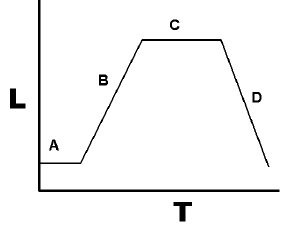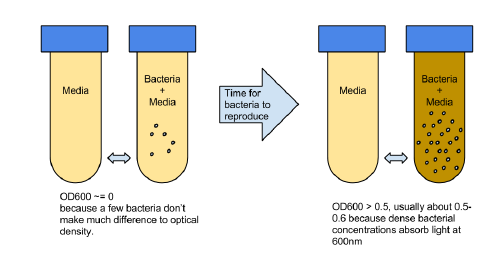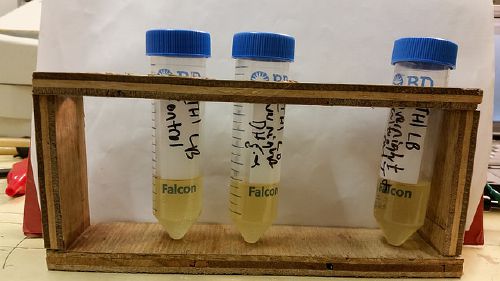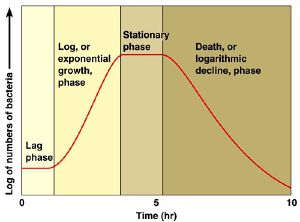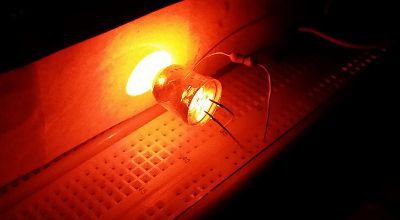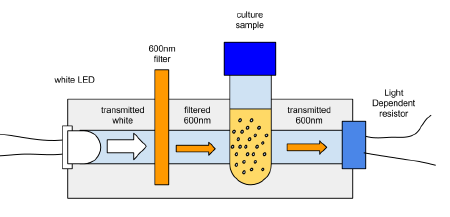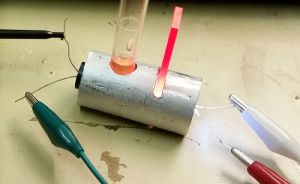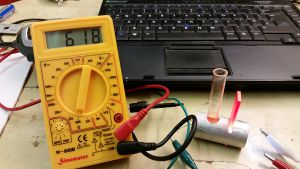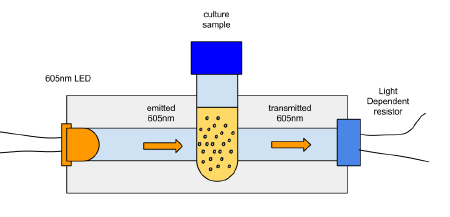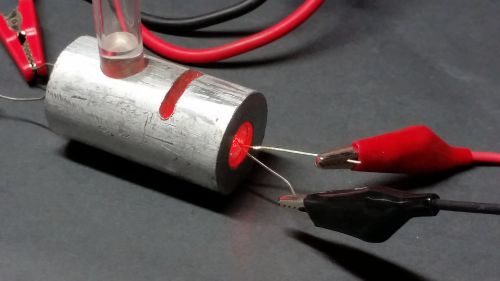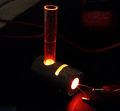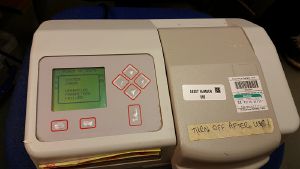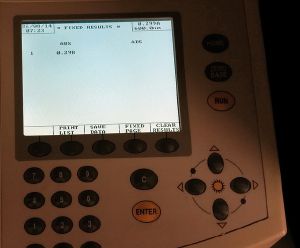Difference between revisions of "Project:OD600 Measurement"
m |
m (→OD600 ???) |
||
| (28 intermediate revisions by the same user not shown) | |||
| Line 1: | Line 1: | ||
| + | [[File:Bacterial growth.png|thumb|right]] | ||
| + | In the molecular biology of bacteria, it is often useful to obtain bacteria at the most productive stage of their population growth cycle. This stage is known as exponential phase, and more specifically the mid-exponential phase of growth is the most productive of that. This phase is also referred to as the "log phase", because plotting the log of the cell number against time produces a straight line. So a protocol might say something like "take a mid-log phase culture of DH5-a...." and what it is saying is to start a culture of bacteria, and let it grow until it is mod-log-phase, and then use them at that point in time. | ||
| − | + | == OD600 ??? == | |
OD600 is often used to estimate the current growth phase of a bacteria or other cells in suspension. It means the "optical density of the sample to light of 600nm". The measured OD600 of the sample relative to a plain reference sample, gives an estimate of the concentration of the cells in the liquid, which can be used to estimate the growth phase of the population. | OD600 is often used to estimate the current growth phase of a bacteria or other cells in suspension. It means the "optical density of the sample to light of 600nm". The measured OD600 of the sample relative to a plain reference sample, gives an estimate of the concentration of the cells in the liquid, which can be used to estimate the growth phase of the population. | ||
| − | The basic idea is to | + | The basic idea is to compare a sample of plain media, and a sample of media in which bacteria has been growing. Initially the levels of bacteria will be very low, and the amount of light absorbed by the 2 samples will be similar. |
{| | {| | ||
| | | | ||
| − | [[File:OD600-pictore.png|500px]] | + | [[File:OD600-pictore.png|thumb|500px]] |
|| | || | ||
| − | [[File:14853028140 6a23c3757f k.jpg| | + | [[File:14853028140 6a23c3757f k.jpg|thumb|500px]] |
|} | |} | ||
| − | The 2 samples are then placed in an incubator, and over time as the number of bacteria grow, this relative value will change according to the growth phase of the bacteria. | + | The 2 samples are then placed in an incubator, and over time as the number of bacteria grow, this relative value will change according to the growth phase of the bacteria. At the beginning the OD600 measures close to zero, because the bacterial population in is the early lag growth phase, and there are few bacteria in total. Reproduction accelerates, and the bacteria are at their most reproductive during the log or exponential phase, which usually corresponds to 0.5-0.6 OD600. Beyond these values, the bacterial population will stabilize and then decline. |
[[File:Growthcurve.jpeg|300px]] | [[File:Growthcurve.jpeg|300px]] | ||
| − | 600nm is in the visible wavelength an is approximately orange. These are some 605nm LEDs from ebay | + | Beyond the stationary phase, the OD600 will continue to increase, and the media will darken, but this is mostly due to large numbers of dead bacteria in the mixture. Populations of bacteria at this phase can be used to inoculate a fresh culture, but are generally useless for competency. |
| − | [[File:16227785328 baea849a33 c.jpg|400px]] | + | |
| + | == Wavelengths of light == | ||
| + | |||
| + | 600nm is in the visible wavelength an is approximately orange. These are some 605nm LEDs from ebay. 600nm light is preferred to UV for example, because its much less phototoxic at those energies. It is also a wavelength at which organic materials readily absorb light. | ||
| + | [[File:16227785328 baea849a33 c.jpg|400px|right]] | ||
[[File:27030-004-293E0372.jpg]] <br /> | [[File:27030-004-293E0372.jpg]] <br /> | ||
(Image: http://kids.britannica.com/comptons/art-57434/When-white-light-is-spread-apart-by-a-prism-or) | (Image: http://kids.britannica.com/comptons/art-57434/When-white-light-is-spread-apart-by-a-prism-or) | ||
| − | |||
| − | + | == OD600 device == | |
| + | The idea is to make a cheap, robust, reliable hand held device that would do OD600 within the requirements of a diybio lab. The initial brain storming is to take a broad wavelength source of light which includes plenty of 600nm and use a 600nm BP filter and a level detector, and calibrate it to match 0.4 at OD600 on a proper spectrophotometer. | ||
| + | === v0.1 === | ||
| − | + | [[File:OD600-proto-1.png|450px]] | |
The initial attempt was to use a white led with a filter for something approximating 600nm | The initial attempt was to use a white led with a filter for something approximating 600nm | ||
| − | [[File: | + | [[File:16229812989 10220d5532 h.jpg|thumb|left]] |
| − | |||
| + | [[File:14853907550 b7212c3efe k.jpg|thumb|left]] | ||
<gallery> | <gallery> | ||
| Line 43: | Line 50: | ||
At the moment the main issue is that the LDR (light dependent resistor) only sees about 20 ohms of difference between the initial inoculation and the mid-log phase, which shows as 0.4 OD600 on a spectrophotometer. | At the moment the main issue is that the LDR (light dependent resistor) only sees about 20 ohms of difference between the initial inoculation and the mid-log phase, which shows as 0.4 OD600 on a spectrophotometer. | ||
| + | |||
| + | It really needs some amplification and a lot more light shielding. | ||
| + | |||
| + | <br clear=left/> | ||
| + | |||
| + | === v0.2 === | ||
| + | |||
| + | the second idea (once the 605nm LEDs had turned up from ebay); | ||
| + | |||
| + | [[File:OD600-proto-2.png|450px]] | ||
| + | |||
| + | [[File:15795926873 abadffc3bc k.jpg|500px]] | ||
| + | |||
| + | <gallery> | ||
| + | File:15795820643 73d7988377 k.jpg | ||
| + | File:15793376844 99165c6bfe k.jpg | ||
| + | </gallery> | ||
| + | |||
| + | == Other stuff == | ||
| + | |||
If you don't have access to a spectrophotometer, (or even if you do), this should be a convenient way to estimate OD600 values for your sample | If you don't have access to a spectrophotometer, (or even if you do), this should be a convenient way to estimate OD600 values for your sample | ||
| Line 51: | Line 78: | ||
http://www.perkinelmer.co.uk/CMSResources/Images/44-136839TCH_Validating_UV_Visible.pdf | http://www.perkinelmer.co.uk/CMSResources/Images/44-136839TCH_Validating_UV_Visible.pdf | ||
| − | |||
== alternative ideas == | == alternative ideas == | ||
| Line 70: | Line 96: | ||
http://www.researchgate.net/post/How_to_exactly_determine_the_OD600_of_Ecoli_suspension | http://www.researchgate.net/post/How_to_exactly_determine_the_OD600_of_Ecoli_suspension | ||
| + | |||
| + | == Open Source Spectrophotometer projects == | ||
| + | |||
| + | === Cambridge iGEM 2010 E.glometer === | ||
| + | |||
| + | "We designed and built a low cost electronic system for measuring light output, this is useful for reporter assays." | ||
| + | |||
| + | http://2010.igem.org/Team:Cambridge/Tools/Eglometer | ||
| + | |||
| + | === OSS Spectrophotometer === | ||
| + | |||
| + | https://github.com/lopenlab/OSS-Spectrophotometer | ||
| + | |||
| + | |||
| + | === Aachen OD/F device === | ||
| + | |||
| + | "Measuring Optical Density (OD) or absorbance is one of the indispensable elements in the field of microbiology. One question that has to be answered often is how many cells are in a suspension? Here, the OD can give a hint. However, the commercially available OD meters are expensive and limit its application and usage in low budget institutions. | ||
| + | |||
| + | Therefore, here we present our OD/F Device. The device is specifically designed for biohackspaces, Do It Yourself (DIY), community laboratories and schools. With our OD/F Device, we aim to enable precise and inexpensive scientific research." | ||
| + | |||
| + | http://2014.igem.org/Team:Aachen/OD/F_device | ||
| + | |||
| + | components of device; | ||
| + | |||
| + | http://2014.igem.org/Team:Aachen/Notebook/Engineering/ODF#diy | ||
| + | |||
| + | |||
| + | == Commercial Spectrophotometers == | ||
| + | |||
| + | The procedure is normally carried out using a visible light capable spectrophotometer like this one; | ||
| + | |||
| + | |||
| + | {| | ||
| + | | | ||
| + | [[File:15087049272 feb8d357df c.jpg|thumb]] | ||
| + | || | ||
| + | [[File:14853897630 82caf9a2f2 z.jpg|thumb]] | ||
| + | |} | ||
| + | |||
| + | |||
| + | But one of these, the are not that expensive? | ||
| + | |||
| + | http://www.laboratory-equipment.com/laboratory-equipment/cell-density-meter.php | ||
| + | |||
[[Category:Biohacking]] | [[Category:Biohacking]] | ||
Latest revision as of 06:57, 1 February 2015
In the molecular biology of bacteria, it is often useful to obtain bacteria at the most productive stage of their population growth cycle. This stage is known as exponential phase, and more specifically the mid-exponential phase of growth is the most productive of that. This phase is also referred to as the "log phase", because plotting the log of the cell number against time produces a straight line. So a protocol might say something like "take a mid-log phase culture of DH5-a...." and what it is saying is to start a culture of bacteria, and let it grow until it is mod-log-phase, and then use them at that point in time.
OD600 ???
OD600 is often used to estimate the current growth phase of a bacteria or other cells in suspension. It means the "optical density of the sample to light of 600nm". The measured OD600 of the sample relative to a plain reference sample, gives an estimate of the concentration of the cells in the liquid, which can be used to estimate the growth phase of the population.
The basic idea is to compare a sample of plain media, and a sample of media in which bacteria has been growing. Initially the levels of bacteria will be very low, and the amount of light absorbed by the 2 samples will be similar.
The 2 samples are then placed in an incubator, and over time as the number of bacteria grow, this relative value will change according to the growth phase of the bacteria. At the beginning the OD600 measures close to zero, because the bacterial population in is the early lag growth phase, and there are few bacteria in total. Reproduction accelerates, and the bacteria are at their most reproductive during the log or exponential phase, which usually corresponds to 0.5-0.6 OD600. Beyond these values, the bacterial population will stabilize and then decline.
Beyond the stationary phase, the OD600 will continue to increase, and the media will darken, but this is mostly due to large numbers of dead bacteria in the mixture. Populations of bacteria at this phase can be used to inoculate a fresh culture, but are generally useless for competency.
Wavelengths of light
600nm is in the visible wavelength an is approximately orange. These are some 605nm LEDs from ebay. 600nm light is preferred to UV for example, because its much less phototoxic at those energies. It is also a wavelength at which organic materials readily absorb light.

(Image: http://kids.britannica.com/comptons/art-57434/When-white-light-is-spread-apart-by-a-prism-or)
OD600 device
The idea is to make a cheap, robust, reliable hand held device that would do OD600 within the requirements of a diybio lab. The initial brain storming is to take a broad wavelength source of light which includes plenty of 600nm and use a 600nm BP filter and a level detector, and calibrate it to match 0.4 at OD600 on a proper spectrophotometer.
v0.1
The initial attempt was to use a white led with a filter for something approximating 600nm
At the moment the main issue is that the LDR (light dependent resistor) only sees about 20 ohms of difference between the initial inoculation and the mid-log phase, which shows as 0.4 OD600 on a spectrophotometer.
It really needs some amplification and a lot more light shielding.
v0.2
the second idea (once the 605nm LEDs had turned up from ebay);
Other stuff
If you don't have access to a spectrophotometer, (or even if you do), this should be a convenient way to estimate OD600 values for your sample
A secondary project is to cast some 12mm x 12mm resin blocks to be used for calibration against a system that takes a cuvette.
Here is a document describing various methods for calibrating spectrophotometers;
http://www.perkinelmer.co.uk/CMSResources/Images/44-136839TCH_Validating_UV_Visible.pdf
alternative ideas
use a stain that binds to a protein that is only expressed during exponential growth phase
DNA Pol II is only expressed during the stationary period of growth, and so might be used as a marker for the end of exponential growth
omp regulates response to osmolarity is expressed in postexponential phase; (Connell et al 1987)
references
What you need to know about OD600 http://bitesizebio.com/1005/what-you-need-to-know-about-od600/
http://www.researchgate.net/post/How_to_exactly_determine_the_OD600_of_Ecoli_suspension
Open Source Spectrophotometer projects
Cambridge iGEM 2010 E.glometer
"We designed and built a low cost electronic system for measuring light output, this is useful for reporter assays."
http://2010.igem.org/Team:Cambridge/Tools/Eglometer
OSS Spectrophotometer
https://github.com/lopenlab/OSS-Spectrophotometer
Aachen OD/F device
"Measuring Optical Density (OD) or absorbance is one of the indispensable elements in the field of microbiology. One question that has to be answered often is how many cells are in a suspension? Here, the OD can give a hint. However, the commercially available OD meters are expensive and limit its application and usage in low budget institutions.
Therefore, here we present our OD/F Device. The device is specifically designed for biohackspaces, Do It Yourself (DIY), community laboratories and schools. With our OD/F Device, we aim to enable precise and inexpensive scientific research."
http://2014.igem.org/Team:Aachen/OD/F_device
components of device;
http://2014.igem.org/Team:Aachen/Notebook/Engineering/ODF#diy
Commercial Spectrophotometers
The procedure is normally carried out using a visible light capable spectrophotometer like this one;
But one of these, the are not that expensive?
http://www.laboratory-equipment.com/laboratory-equipment/cell-density-meter.php
